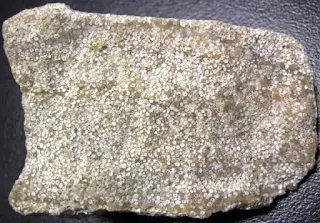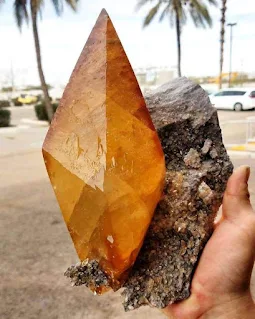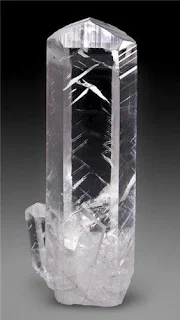Crystal Habits and Forms
The term crystal habit describes the favored growth pattern of the crystals of a mineral species, whether individually or in aggregate. It may bear little relation to the form of a single, perfect crystal of the same mineral, which would be classified according to crystal system. Subtle evidence of the crystal system to which a mineral species belongs is, however, frequently observed in the habit of the crystals which a specimen displays.
The terminology used to describe crystal habit is not intended to replace the precise nomenclature of crystallography. Instead, it is intended as a supplement to this system.
Discussions of crystal habit are more descriptive than precise; for this reason the terminology is suited to the discussion of mineral samples discovered in the field. Naturally formed specimens are rarely quantitatively perfect.
 |
| Crystal Habits and Forms |
The crystals of particular minerals species sometimes form very distinctive, characteristic shapes. Crystal habit is thus often useful in identification.
Although each mineral species typically forms according to a few preferred shapes, crystal habit is largely determined by the environmental conditions under which a crystal develops. For example, aqueous solutions near or surrounding a crystal contain the elemental substances which it needs to continue growth.
The direction from which a growing crystal may obtain such solutions is a factor which will affect its eventual shape. Higher environmental temperatures during formation increase ion mobility and aid in crystal formation; the rate at which the environment cools determines how much time a mineral is allowed to form large crystals. The amount of space available for a crystal to fill affects its final shape and size.
Surface energy relations are also quite important to the direction of crystal growth; this process is not yet fully understood.Adjectives used to describe the habit of individual crystals are 'equant,' 'prismatic,' and 'tabular.' Aggregates of crystals may also be termed equant or prismatic, while aggregates of thin, flat, tabular crystals may be 'bladed.' Thin sheets, flakes or scales are termed 'foliated,' 'micaceous,' and, if feathery or delicate, 'lamellar' or 'plumose.'
Crystal aggregates resembling long, slender needles, hair, or thread are termed 'acicular,' filiform,' 'capillary,' or 'fibrous.' An aggregate of crystals forming a network or lattice is 'reticulated;' one composed of branches which radiate starlike from a central point is 'stellated' while a branching and treelike mineral growth is 'dendritic.'
'Colloform' crystal habits termed 'botryoidal,' 'mamillary,' and 'reniform' display spherical, bulbous or globular lumps. Smaller spherical forms are of 'pisolitic' or 'oolitic' habit; ovoid clusters or formations are 'amygdaloidal.'
Tapered, column-like formations are 'stalactitic' or 'columnar' while concentrically banded formations are of 'concretionary' habit. Minerals whose flat crystal faces are covered with shallow, parallel grooves are 'striated;' a fine furry layer of crystals growing over a massive lump constitutes a formation of 'drusy' habit.
Crystal Habits and Forms Include:
Equant
Equant crystal habit is a type of crystal habit in which the crystals are roughly equidimensional, meaning that they have approximately the same length, width, and height. Equant crystals are often described as being blocky or cubic in shape.Lamellar
Lamellar crystal habit refers to crystals that are flat and plate-like. The crystals are typically thin and can be stacked on top of each other like sheets of paper. Lamellar crystal habit is formed when the mineral crystals grow in a direction that is parallel to the surface of the crystal. This can happen for a number of reasons, including the presence of impurities in the crystal, the orientation of the crystal in the growth environment, or the way that the crystal is deposited.Prismatic
A prismatic crystal is elongated in one direction like a prism. The mineral tourmaline often forms crystals of such habit.Tabular
Tabular crystals are flat and plate-like. They have lengths and widths that are much larger than their thickness. An easy way to describe their shape is to compare them to a tablet computer or a tablet that you use to write notes.Bladed
A bladed crystal habit is a type of crystal habit in which the crystals are elongated and flattened, like a knife blade. The crystals are much longer than they are wide, and their width exceeds their depth. Gypsum often displays crystals of bladed habit.Micaceous
Minerals of micaceous habit form as thin, flat sheets or flakes which are easily peeled or split off the larger mass. Muscovite provides an example of micaceous habit. Crystals of foliated habit are separable into leafy structures or display leaflike projections. |
| Hopper halite. Photo: Spirifer Minerals |
Hopper
A hopper crystal is a form of crystal, defined by its "hoppered" shape. The edges of hoppered crystals are fully developed, but the interior spaces are not filled in. This results in what appears to be a hollowed out step lattice formation, as if someone had removed interior sections of the individual crystals. In fact, the "removed" sections never filled in, because the crystal was growing so rapidly that there was not enough time (or material) to fill in the gaps. |
| Plumose Aurichalcite. Photo: Rob Lavinsky |
Plumose
Plumose crystal habit is a type of crystal growth that produces fine, feathery scales. The term "plumose" comes from the Latin word "pluma", which means "feather". Plumose crystals are typically found in minerals that have a layered crystal structure, such as micas and chlorites. The layers of the crystal grow in a fan-like or feather-like pattern, resulting in the characteristic appearance. |
| Acicular agardite-Ce. Photo: Joy Desor Mineralanalytik |
Acicular
The adjective 'acicular' means needlelike in shape. An acicular aggregate of crystals contains many long, slender crystals which may radiate out like needles or bristles from a common base. Acicular crystals are typically long and narrow like a pine leaf and seem to possess a sharp point. The mineral natrolite often exhibits acicular crystals. |
| Filiform Malachite. Photo: Sandro Bonfiglio |
Filiform
A mineral possessing crystals of filliform habit exhibits many hairlike or threadlike filaments. The crystals are typically very thin and long, and they may be aggregated together to form mats or felt-like masses. "Filiform' is derived from the Latin word filum, 'thread.' |
| Chrysotile fibrous crystal habit. Photo: Eurico Zimbresxa |
Fibrous
Fibrous crystal habit is a type of crystal habit in which the crystals are elongated and thread-like. The fibers are often parallel to each other, but they can also be randomly oriented. Specimens possessing fibrous habit exhibit clumps of sinewy, stringy, or hairlike fibers. The fibrous crystal habit is caused by the way that the mineral crystals grow. The crystals grow in a direction that minimizes the surface energy of the crystal. In the case of fibrous crystals, the direction of growth is parallel to the longest dimension of the crystal. |
| Cerussite (Reticulated Habit). Photo: Crystal Classics |
Reticulated
Reticulated crystal habit is a type of crystal habit in which the crystals are interconnected in a network or lattice-like pattern. This type of crystal habit is often seen in minerals that have a high surface energy, such as rutile and cerussite. The word 'reticulated' is derived from the Latin term rete, or 'net.' |
| Stellated Wavellite. Photo: FenderMinerals |
Stellated
A mineral of stellated habit possesses several branches which radiate outwards from the center in a pattern resembling a star. The word 'stellated' stems from the Latin term stella, or 'star.'Dendritic
Dendritic crystal habit is a type of crystal habit in which the crystals have a branching, tree-like appearance. The dendrites are formed when the crystal grows in a supercooled liquid. The liquid is supercooled when it is below its freezing point, but it has not yet frozen. The dendrites form because the crystal grows faster at the tips than at the sides. This causes the crystal to grow in a branching pattern.Native copper sometimes exhibits this habit.Colloform
Colloform crystal habit is a type of crystal habit in which the crystals are spherical, rounded, or bulbous. It is characterized by a radiating growth of crystals, without regard to size. The word "colloform" comes from the Latin word "collo," meaning "glue." |
| botryoidal chalcedony |
Botryoidal
The word 'botryoidal' means 'resembling a bunch of grapes,' or globular. Specimens of malachite frequently provide examples of botryoidal crystals. The Greek word botrus, 'bunch of grapes,' provides the linguistic root of botryoidal. |
| Mammillary Erythrite. |
Mammillary
Mammillary crystal habit is a type of crystal habit in which the crystals are rounded and have a bumpy or knobby surface. The name comes from the Latin word "mammilla," which means "nipple."Reniform
Reniform crystal habit displays the shape of a kidney. The mineral species hematite provides samples which exemplify both mammillary and reniform habit. 'Reniform' is derived from the Latin renes, 'kidney.' |
| Oolitic Calcite. Photo: James St. John |
Oolitic
Oolitic crystal habit is a type of crystal habit in which the crystals are spherical or oval-shaped. The crystals are typically less than 4 millimeters in diameter. Oolitic crystals are often found in sedimentary rocks, such as limestone and dolomite.Oolitic crystals form when minerals precipitate from water. The minerals are deposited around a nucleus, such as a grain of sand or a piece of organic matter. The crystals grow in layers, which gives them their characteristic spherical or oval shape.
 |
| Pisolitic bauxite Photo: James St. John |
Pisolitic
Pisolitic crystal habit is a type of crystal habit in which the crystals are small, rounded, and concentrically layered. A mineral of pisolitic habit develops round, pea-shaped forms. These are larger and slightly more uneven than an oolite and are usually composed of calcium carbonate. The word 'pisolitic' is derived from the Greek term pisos, 'pea.' Pisolitic crystals are typically found in sedimentary rocks, such as bauxite and sandstone. They are formed when mineral-rich water percolates through the rock and deposits layers of minerals around a nucleus. The nucleus can be a grain of sand, a piece of organic matter, or even a void.Stalactitic
Stalactitic or columnar crystal habit refers to the tall, tapered, columlike appearance of an icicle or a limestone stalactite. Such formations are built up by the dripping of mineral-laden solution. The minerals calcite and aragonite (CaCO3) typically form stalactites. The term is derived from the Greek word stalaktos, 'dripping.' |
| Pyrite Concretions |
Concretionary
Concretionary crystal habit is a type of crystal habit in which the crystals are formed by the concentric deposition of mineral matter around a nucleus. The nucleus can be a small piece of rock, a plant or animal remains, or even a gas bubble.Concretions can be formed in a variety of environments, including sedimentary rocks, soils, and groundwater. The shape of a concretion is determined by the shape of the nucleus and the way that the mineral matter is deposited.
 |
| Striated pyrite |
Striated
Striated crystal habit is a type of crystal habit in which the crystals have parallel lines or grooves on their surface. The striations are caused by the way that the crystal grows. As the crystal grows, it may encounter impurities or other obstacles that slow down the growth of certain faces of the crystal. This can create parallel lines or grooves on the surface of the crystal. |
| Drusy quartz |
Drusy
A drusy crystal habit is a type of crystal habit in which the crystals are tightly packed together and form a kind of crust or coating on a surface. The crystals are typically small and have a rounded shape. |
| Kyanite with Quartz Crystal from Brazil |











%20(1).webp)






